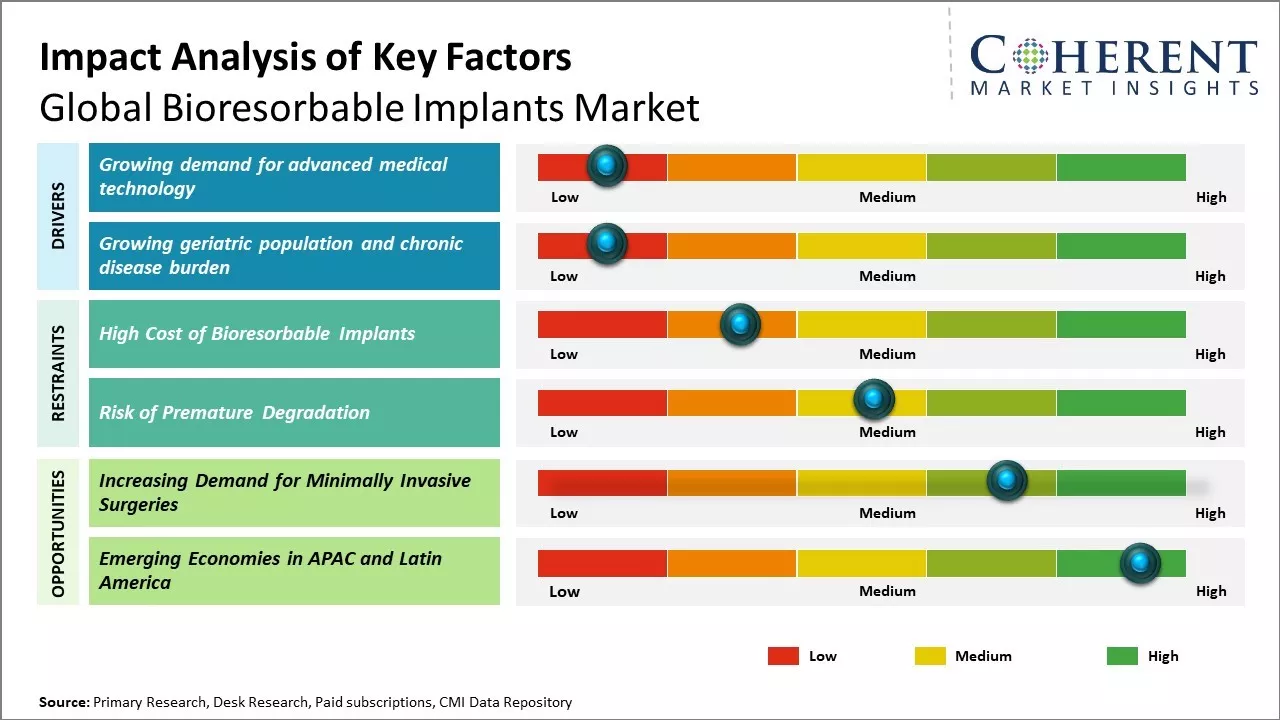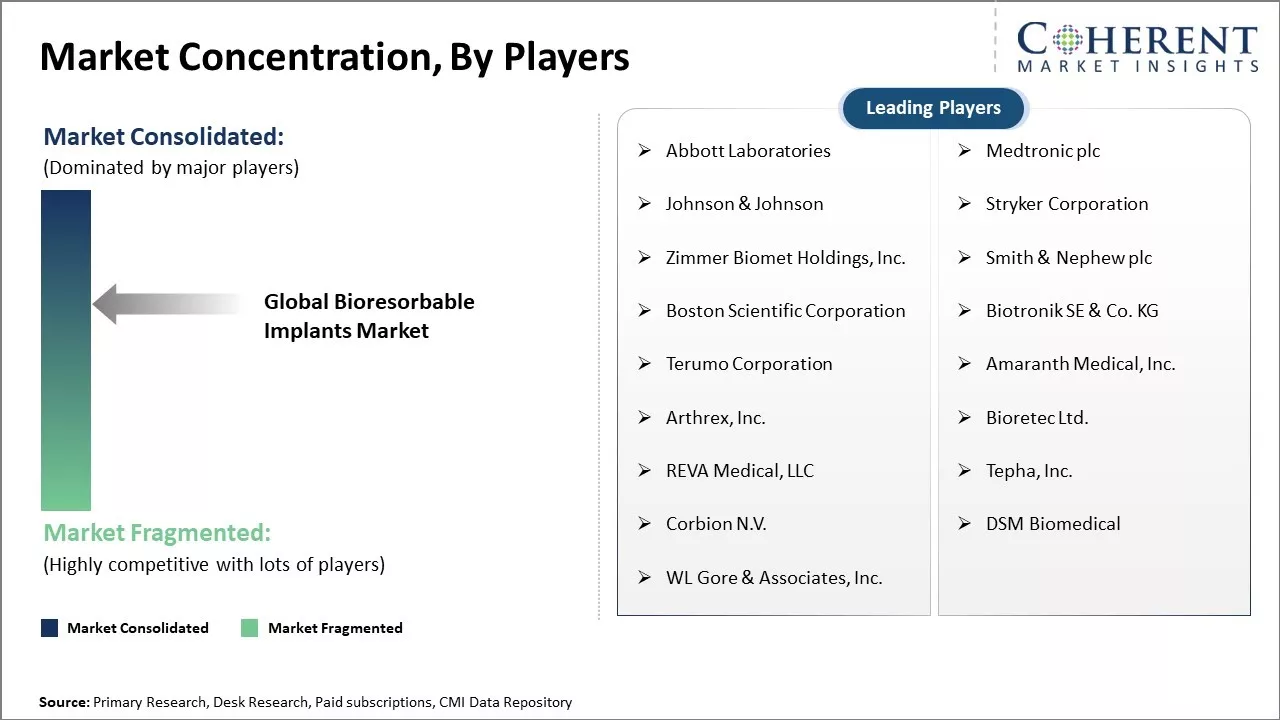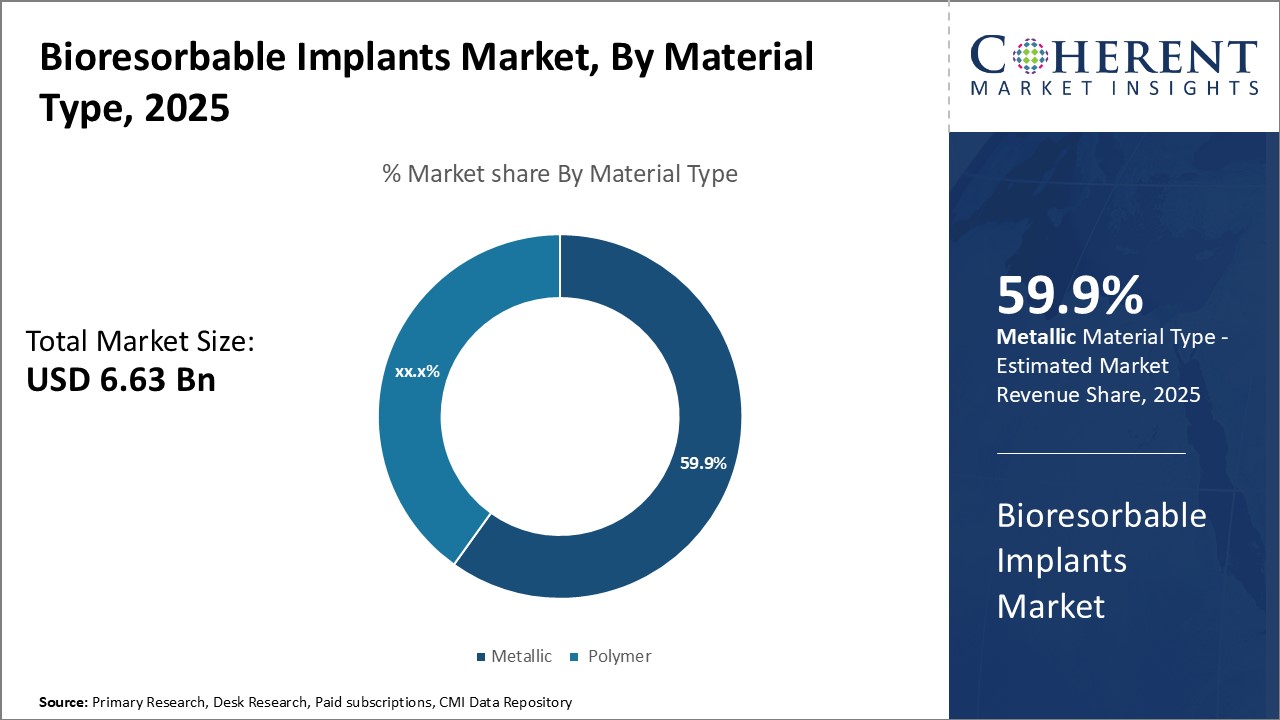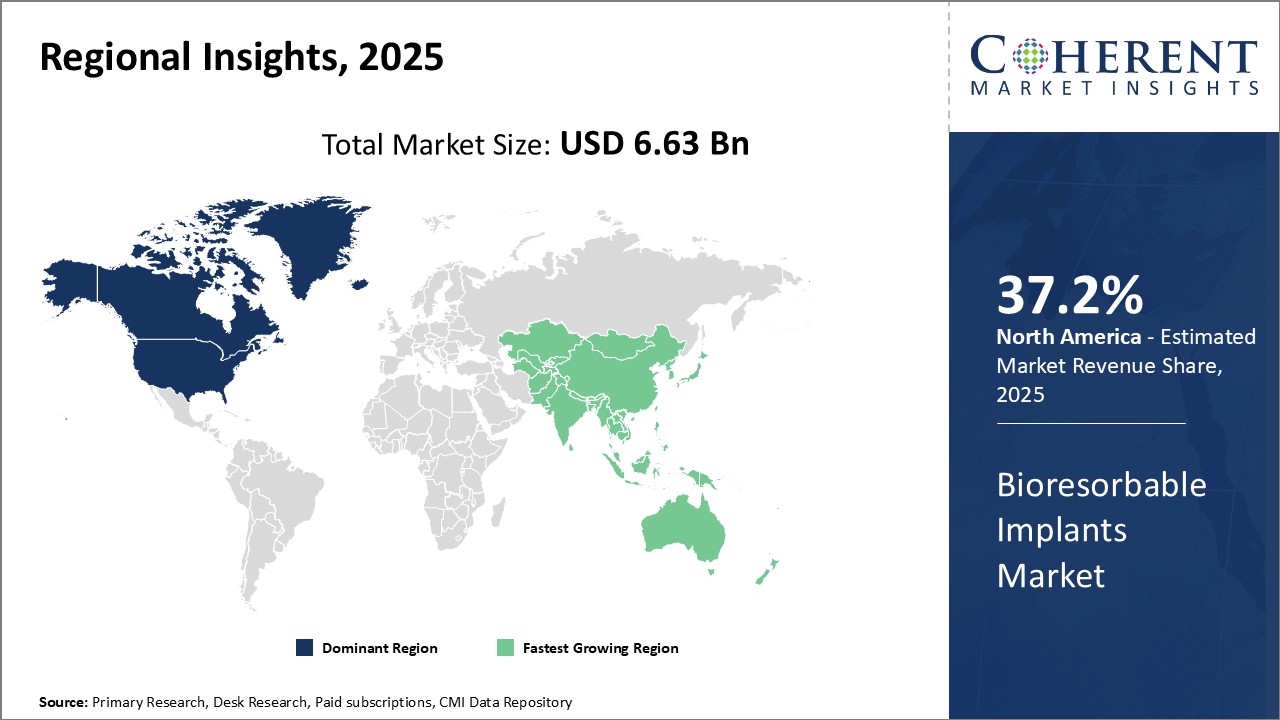Global bioresorbable implants market is estimated to be valued at USD 6.63 Bn in 2025 and is expected to reach USD 11.90 Bn by 2032, exhibiting a compound annual growth rate (CAGR) of 8.7% from 2025 to 2032.

Discover market dynamics shaping the industry: Download Free Sample
Growing prevalence of chronic diseases coupled with rising investments in R&D of regenerative medicine can drive the global bioresorbable implants market growth. The market growth is driven by rising number of trauma cases and accidents globally. Furthermore, growing geriatric population prone to chronic diseases like orthopedic disorders can also drive the market growth. However, high costs of bioresorbable implants and lack of awareness in low-income countries can hamper the market growth. Ongoing research and development of advanced bioresorbable materials can offer new opportunities for market players.
Growing demand for advanced medical technology
Global bioresorbable implants market growth is driven by increasing demand for advanced medical devices and technologies across the globe. These implants are majorly used for fracture fixation, drug delivery systems, and vascular stents that are used in orthopedic, cardiovascular and neurological conditions. As these disorders impose a significant burden on populations, there is growing prioritization on developing innovative solutions to treat patients effectively with minimal complications. Bioresorbable implants offer various clinical advantages over conventional metallic implants as these get absorbed naturally in the body once the healing process is complete, thus, eliminating the need for repeated surgeries to remove them. This reduces post-operative risks and healthcare costs. Their biocompatible properties prevent long-term interference with diagnostic imaging tests and enable closely monitoring tissue regeneration at the implantation site. Such benefits have made them an attractive alternative to permanent implants among both physicians and patients. Advancements in material engineering enable manufacturers to design implants with customized degradation profiles matching the healing timeline of different tissues. Gradually resorbing structures mimic the body's natural process of laying down new bone material or vascular walls. This facilitates regeneration of native tissue architecture without leaving any foreign remnants. Ongoing R&D into novel biomaterials, drug coating technologies, 3D printing applications and bioresorbable polymer composites can expand the scope of usable implantation sites.

Get actionable strategies to beat competition: Download Free Sample
Growing geriatric population and chronic disease burden
Growing geriatric population particularly in developed nations can boost demand for sophisticated biomedical solutions. Older patients often have co-morbidities that necessitate multiple joint replacement surgeries or interventions to restore vessel patency or nerve conductivity over their lifetime. Bioresorbable implants eliminate future complications from permanent metallic implants and reduce vulnerability to device-related infections in this cohort. Chronic, non-communicable diseases such as cardiovascular illnesses, diabetes, musculoskeletal disorders are rising globally due to lifestyle changes and expanding life expectancy. This growing disease burden has substantially raised the requirement for implant devices to treat fractures, artery blockages or other morbidities resulting from these conditions. Since these patients may require lifelong management over decades, bioresorbable implants that safely dissolve post-treatment help avoid undesirable long-term effects of permanent implants.
Key Takeaways from Analyst:
Increasing prevalence of chronic diseases and rising number of surgical procedures can boost demand for bioresorbable medical devices. As these implants dissolve naturally in the body after serving their intended function, these eliminate the need for subsequent surgical removal of permanent implants. This reduces postoperative complications and recovery time for patients. North America currently dominates the market due to rising healthcare spending and growing acceptance of advanced medical technologies. However, Asia Pacific is likely to emerge as the fastest growing region due to increasing spending on healthcare and a large chronic disease burden.
Increasing R&D investments by key players to develop advanced bioresorbable materials for a wide range of applications can offer lucrative growth opportunities, however, high costs of these implants as compared to conventional permanent implants can hamper its widespread adoption in price sensitive markets. Biocompatibility issues and unpredictable degradation rates can also pose challenges for manufacturers. Furthermore, limited clinical evidence can restricts the scope of applications currently. Global bioresorbable implants market has significant untapped growth potential particularly in Asia and Latin America. However, more clinical studies are required to strengthen clinical efficacy and drive physician preference over traditional options.
Market Challenges: High cost of bioresorbable implants
The high cost of bioresorbable implants as compared to traditional metal implants can hamper its widespread adoption and bioresorbable implants market growth. Bioresorbable implants are made from polymers that slowly dissolve or degrade inside the body over time after surgery. While this provides significant advantages like eliminating the need for implant removal surgery, the specialized materials and manufacturing processes increases its costs. For example, bioresorbable fixation screws and plates used in orthopedic fractures and surgeries currently cost 2-3 times more than their metallic counterparts. The additional R&D expenditures required to customize bioresorption times and mechanical properties of different implants also contribute to high prices. This premium pricing puts bioresorbable implants out of reach for many patients and healthcare providers, especially in developing regions with constrained medical budgets. In 2020, according to the OECD report, about 30% of the population in developing countries lacks sufficient access to even basic surgical and diagnostic services due to high costs. Unless prices of bioresorbable implants come down significantly, this affordability barrier will remain a major handicap for companies trying to expand sales and market reach. Even in developed countries with universal healthcare like Canada, restrictions are imposed on funding for new medical devices and technologies until their long-term cost-effectiveness and benefits over standard options are proven. This precautionary approach delays commercialization and large-scale uptake of innovative but relatively costlier products like bioresorbable implants.
Market Opportunities: Increasing demand for minimally invasive surgeries
Rising demand for minimally invasive surgeries can offer growth opportunities as it provides significant benefits over traditional open surgeries such as less pain, fewer complications, smaller scars and shorter hospital stay. Minimally invasive procedures involve usage of equipment like guides, catheters and implants inserted through small incisions rather than through a large incision. This has created a huge opportunity for bioresorbable implants as these provide advantages over conventional metal implants used in such surgeries.
Bioresorbable implants behave similarly to natural bone and gradually resorb in the body as the surgical site naturally heals, thus, eliminating the need for subsequent surgery to remove the implant. This automatically solves compliance issues related to implant removal. As per a study published by National Health Service U.K., an estimated 20% of patients requiring implant removal refuse the additional surgery due to fears of re-operation or lack of time. With increased usage of bioresorbable implants, such compliance-related problems can be avoided. The temporary nature of bioresorbable implants also makes them an attractive option for pediatric population who might require re-operations as these grow which can be challenging with permanent metallic implants.

Discover high revenue pocket segments and roadmap to it: Download Free Sample
By Material Type - Material Properties Drive Metallic Segment Growth
In terms of material type, metallic segment is estimated to contribute the highest market share of 59.9% in 2025, owing to its intrinsic material properties. Metallic biomaterials like iron, magnesium and zinc have mechanical properties well-suited for load-bearing orthopedic implant applications. Their high strength-to-weight ratio allows for effective structural support without bulky or cumbersome implants. Metals corrode and degrade in a well-controlled and predictable manner inside the body. Special surface coatings and alloy formulations can precisely tailor the corrosion rate of metals to match tissue healing times. This bioresorbable eliminates the need for permanent implants or follow-up surgeries to remove implants after treatment. The avoidance of secondary surgeries substantially reduces healthcare costs and patient recovery times. Metals also exhibit excellent suture and staple retention properties during implantation procedures. Their malleability allows for easy shaping and fabrication into intricate implant designs customized for individual patient anatomies and defect sites. Advanced 3D printing and additive manufacturing techniques have further expanded the design freedom and customizability of metallic implants. The mechanical integrity and manufacturability advantages of metals underpin their continued widespread use for load-intensive orthopedic and trauma applications where robust initial strength is critical.
By Application - Orthopedic Indications Lead Application Segment
In terms of application, orthopedic segment is estimated to contribute the highest market share of 50.6% in 2025, due to rising prevalence of musculoskeletal disorders globally. Common orthopedic indications amenable to bioresorbable implants include fractures, spinal fusion, soft tissue tears and ligament/tendon repairs. According to the National Hospital Ambulatory Medical Care Survey, over 30 million orthopedic procedures are performed annually in the U.S. for bone and joint disorders. As the population ages worldwide, age-associated conditions like osteoarthritis and osteoporosis are rising dramatically, thus, boosting demand for orthopedic surgical interventions. Due to their bioresorbable nature, implants can be employed for “internal fixation” applications during orthopedic procedures without necessitating follow-up implant removals. This enhanced clinical efficiency accelerates patient recovery. Bioresorbable fixation devices also help avoid long-term implant-related complications such as stress-shielding of bone, implant-associated fractures and implant-site infections that can arise with permanent metallic implants. Eliminating long-term foreign bodies from the body prevents chronic inflammatory and immune responses. The biocompatibility of bioresorbable implants facilitates optimal bone healing without impedance from lasting implants.
By End User - Hospital Demand Dominates End User Segment
In terms of end user, hospitals segment is estimated to contribute the highest market share of 40.5% in 2025, owing to their central role in providing specialized surgical care. Most orthopedic, cardiovascular and other complex procedures employing bioresorbable implants are performed in hospitals under the supervision of specialized clinical staff. Hospitals boast high patient volumes, on-site operating rooms, intensive care units and lengthy post-operative care facilities necessary for supporting implant surgeries and recuperation. These also have the infrastructure, trained professionals and large budgets to invest in the latest bioresorbable implant technologies. The shift towards value-based care models is incentivizing hospitals to reduce readmissions, decrease lengths of stay and hasten patient recoveries through upgraded technologies like bioresorbable implants. Faster recovery times and fewer follow-up costs associated with bioresorbable devices help control hospital expenditures in the long run. Many hospital networks also own ambulatory surgical centers, allowing them to capture market share across different end user segments. As clinical awareness about bioresorbable spreads within hospitals globally, more implant procedures will move into these end points of care that can best support advanced surgery and postsurgical recovery.

Need a Different Region or Segment? Download Free Sample
North America dominates the global bioresorbable implants market with an estimated market share of 37.2% in 2025, owing to strong presence of key players and availability of advanced healthcare facilities in the region. The U.S. accounts for majority share in the North American as well as global market. Strong focus on research and development activities coupled with growing adoption of minimally invasive surgeries can drive the market growth in the region. Moreover, favorable regulatory approvals and reimbursement policies also drives the market growth.
Asia Pacific region has emerged as the fastest growing market for bioresorbable implants. Rapidly developing healthcare infrastructure, increasing medical tourism and growing incidences of chronic diseases across major Asian countries including China, India and Japan can drive the market growth. Growing awareness about such innovative implants and improving access to healthcare attracts patients as well as international players in the region. China dominates the Asia Pacific market owing to large patient pool, reduction in treatment costs, and increase in disposable incomes.
Bioresorbable Implants Market Report Coverage
| Report Coverage | Details | ||
|---|---|---|---|
| Base Year: | 2024 | Market Size in 2025: | USD 6.63 Bn |
| Historical Data for: | 2020 To 2024 | Forecast Period: | 2025 To 2032 |
| Forecast Period 2025 to 2032 CAGR: | 8.7% | 2032 Value Projection: | USD 11.90 Bn |
| Geographies covered: |
|
||
| Segments covered: |
|
||
| Companies covered: |
Abbott Laboratories, Medtronic plc, Johnson & Johnson, Stryker Corporation, Zimmer Biomet Holdings, Inc., Smith & Nephew plc, Boston Scientific Corporation, Biotronik SE & Co. KG, Terumo Corporation, Amaranth Medical, Inc., Arthrex, Inc., Bioretec Ltd., REVA Medical, LLC, Tepha, Inc., Corbion N.V., DSM Biomedical, WL Gore & Associates, Inc. |
||
| Growth Drivers: |
|
||
| Restraints & Challenges: |
|
||
Uncover macros and micros vetted on 75+ parameters: Get instant access to report
*Definition: Bioresorbable implants market involves medical devices that are used for surgical procedures and made of materials that safely dissolve and are absorbed by the body over time. These implants, such as fixation devices, sutures, and scaffolds, are inserted into the body during operations to provide temporary support for healing or reconstructive procedures. These slowly degrade in the body as new bone or tissue forms, eventually eliminating the need for surgical removal as the body naturally resorbs the implant materials on its own. Bioresorbable implants aim to overcome limitations of permanent implants while allowing natural healing.
Share
Share
About Author
Manisha Vibhute is a consultant with over 5 years of experience in market research and consulting. With a strong understanding of market dynamics, Manisha assists clients in developing effective market access strategies. She helps medical device companies navigate pricing, reimbursement, and regulatory pathways to ensure successful product launches.
Missing comfort of reading report in your local language? Find your preferred language :
Transform your Strategy with Exclusive Trending Reports :
Frequently Asked Questions
Joining thousands of companies around the world committed to making the Excellent Business Solutions.
View All Our Clients